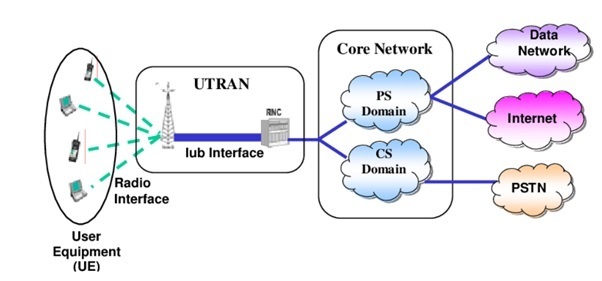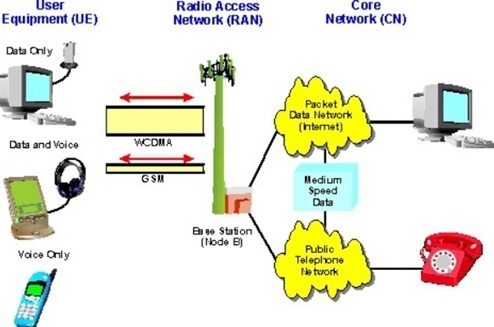
 Data Structure
Data Structure Networking
Networking RDBMS
RDBMS Operating System
Operating System Java
Java MS Excel
MS Excel iOS
iOS HTML
HTML CSS
CSS Android
Android Python
Python C Programming
C Programming C++
C++ C#
C# MongoDB
MongoDB MySQL
MySQL Javascript
Javascript PHP
PHP
- Selected Reading
- UPSC IAS Exams Notes
- Developer's Best Practices
- Questions and Answers
- Effective Resume Writing
- HR Interview Questions
- Computer Glossary
- Who is Who
Difference Between UMTS and WCDMA
Overview
Mobile phones have advanced significantly. If you take a look, we have gradually moved on from the days where our mobile phones had poor audio quality, frequent dropped calls, and security issues to the latest today where we have high quality audio connectivity along with streaming videos, sending simple text or multimedia messages even without connecting to the Wi-Fi. Behind the scenes of this analog to digital modulation are multiple technologies which helped the cell phone communication evolve gradually from 1G to 5G features that we enjoy today.
This article will speak on two such technologies, UMTS and WCDMA. Many a times, UMTS and WCDMA are used interchangeably. But, they have their own set of pros and cons. Let's dive into this article to have a deeper insight on both UMTS and WCDMA.
What is UMTS?
UMTS stands for Universal Mobile Telecommunications System, a wireless radio technology clubbed with the 3G cellular networks. It was initially deployed in North America in 2000s by AT&T. UMTS defines the third generation of GSM (Global System for Mobile Communications) or in simple terms, it is now more often referred to as the 3G technology. UMTS is an extension of its former version-the 2G GSM technology.
In a GSM communication technology, the frequency spectrum is broken down into smaller channels and distributed in different time slots. However, this was not feasible for huge data transfer in a short time. This was when UMTS was created. Although UMTS facilitated high speed data transfers, it could never replace the GSM technology and remained as a complementary technology to GSM. An UMTS system can transfer data up to 2 megabits per second.
Working Methodology of an UMTS System

Types of UMTS
There are two types of UMTS ?
- Frequency Division Duplex (FDD) ? Requires a paired spectrum or two separate communication channels to receive or send signals.
- Time Division Duplex (TDD) ? Depends on a single channel to receive and transmit signals.
Advantages of UMTS
- High speed data transfer enables users to stream and/or download content at a faster rate.
- With enhanced call quality, the audio connectivity and the frequent call drop issues have been resolved to a greater extent.
- Multimedia services such as video calling, gaming, mobile TV usage improved with UMTS.
- Worldwide roaming facility provided UMTS users to connect with each other irrespective of their country of residence.
- Better customer experience and wide bandwidth, reliability and ease of application are other proven advantages of an UMTS system.
Disadvantages of UMTS
Despite many benefits, UMTS certainly has drawbacks like ?
- Compatibility issues with older cell phones that do not support UMTS networks.
- Security concerns or threats related to the data privacy.
- High cost infrastructure in setting up a UMTS network created an initial burden on service providers.
- Network coverage issues of UMTS were predominant in certain rural and urban areas, thus creating blind spots.
- UMTS also has high power consumption issue with a low battery life.
What is WCDMA?
WCDMA stands for Wideband Code Division Multiple Access. It is an UMTS standard and is based on CDMA. WCDMA is an air-interface technology that uses radio spectrum for data transfer. A different modulation scheme and a wider bandwidth allows WCDMA to provide improved data transfer at higher speeds when compared to other older 2G technologies.
The International Mobile Telecommunications-2000 (IMT 2000) recognised WCDMA as a standard network model to create multimedia services and global roaming. It is a direct spread technology which can spread its transmissions over a 5MZh carrier.
Working Methodology of WCDMA

Advantages of WCDMA
WCDMA has multiple benefits like ?
- High speed data transfer enabling faster downloads and rapid video streaming.
- Enhanced audio quality and connectivity improved the clarity and reliability of communication.
- Improved multimedia services such as video calling, mobile TV, internet access increased the user experience of ECDMA network.
- Similar to UMTS, WCDMA also supports worldwide operability or roaming, i.e. WCDMA users can connect from another part of the word through audio or video calls.
- Better spectral and handover efficiencies of WCDMA network allowed audio communications within a particular network even during movement.
Disadvantages of WCDMA
Though WCDMA proved to be more advantageous over the older cellular technologies, it has certain disadvantages ?
- As WCDMA is complex to handle, and requires optimal planning and execution, it often becomes brainstorming for the service providers.
- Devices with WCDMA network uses high power thereby leading to a low battery life. Batteries demand frequent recharge.
- Setting up a WCDMA infrastructure in low-lying or rural areas is a complicated procedure. Hence, such areas often face network coverage issues.
- As all older cellular phones do not support the WCDMA network, such group of users need a replacement of their handsets to enjoy the WCDMA features.
- Signal interruption is quite common in any of the cellular technologies. However, signal restoration is a time-taking or a lengthy process in WCDMA.
Now that the article has provided a brief insight into what a cellular technology is, the two types of technologies- their pros and cons including their impact on users, service providers, and various other features; we can now give a thought and list down the differences between the two cellular communication technologies- UMTS and WCDMA.
Differences between UMTS and WCDMA
| Parameters of Comparison | UMTS | WCDMA |
|---|---|---|
| Technology | Mobile network technology | Wireless Radio air interface |
| Tools for Communication | UMTS cannot be used alone. It needs to be paired up with other cellular technologies | WCDMA is primarily used in all cell phones. At times, GSM and UMTS are coupled with it. |
| Network Coverage | Coverage area is less, but it is increases when paired with WCDMA | WCDMA has a significant network coverage area |
| Bandwidth | UMTS functions in multiple frequency bands and bandwidths | WCDMA is a wide range air interface standard. |
| Signals | Signals are often challenging to handle. Even when done, interference in communication may still persist | Signals can be handled with ease. Code division channels are also available for division. |
| Data Speed | Data transmission with UMTS can happen with different speeds depending on the technology it is associated with | WCDMA offers a very high speed data transmission when compared to other older cellular technologies |
| Gadget Compatibility | UMTS is compatible with almost all the gadgets as it is compatible with different access technologies | WCDMA is not compatible with certain old-fashioned handsets. |
Conclusion
The technical specifications and methods of deployment of WCDMA and UMTS differ. WCDMA, or wideband code division multiple access, is one of the common mobile technologies of UMTS. Third-generation mobile networks' system architecture and standards are referred to as UMTS, whereas the radio interface technology used in UMTS networks to transmit data over the air is defined by WCDMA. WCDMA is among the numerous radio access technologies employed by the UMTS network. The differences in their working principles, features, benefits and disadvantages have been listed out.
